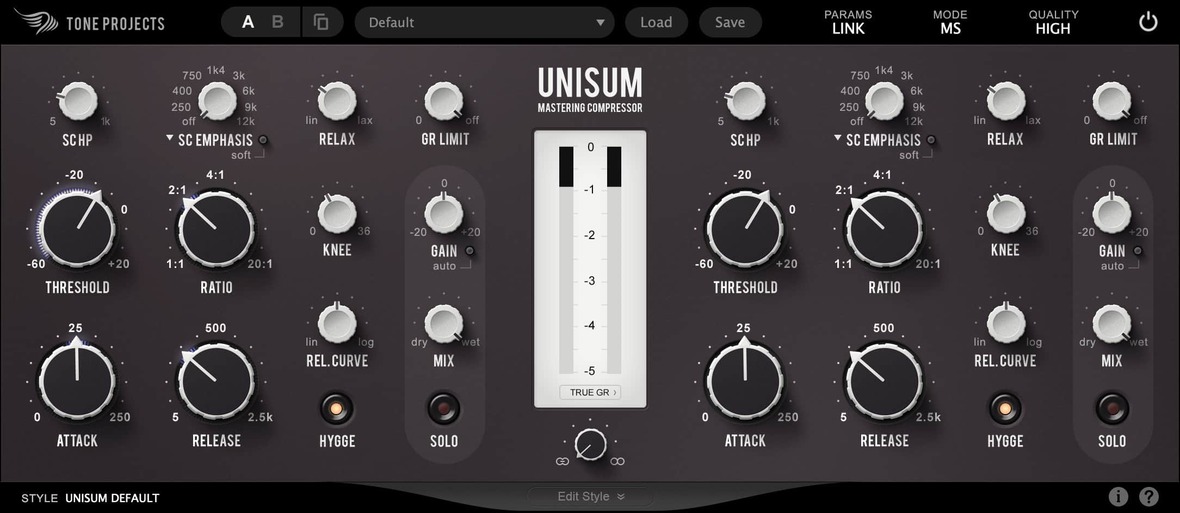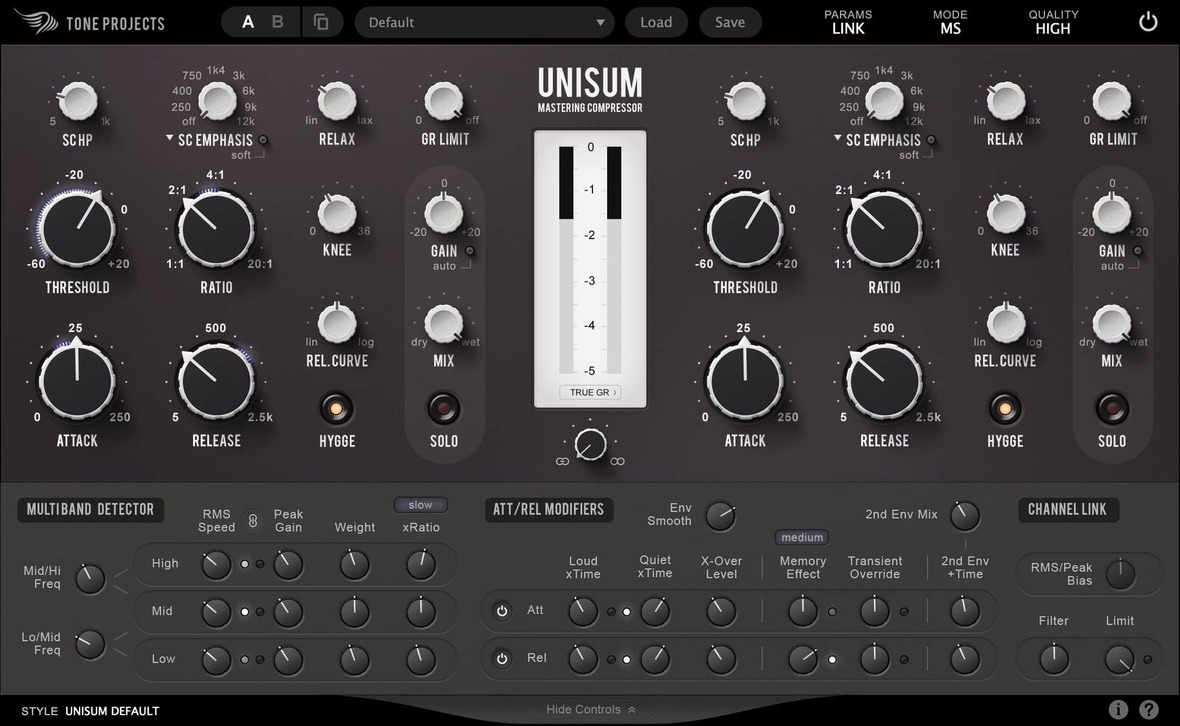
Review by George Shilling
Rune Lund-Hermansen is the brains behind Tone Projects – clearly a man of many talents, as for nearly 7 years he was Lead Product Designer for every wine drinker’s favourite phone app, Vivino. Unisum is perhaps the most comprehensively controllable mastering compressor plug-in ever, with all kinds of detailed parameters available for tweaking that are fixed or hidden in most other compressors.
Relax
On opening the plug-in a central bar type meter dominates, with three selectable zoom scales, appropriate depending on how much compression you are using. Main controls are separate for each channel, although by default they are linked. Big knobs are familiar – Threshold, Ratio, Attack and Release (each with a helpful additional surrounding meter), and there are Wet/Dry Mix and output Gain controls. Sidechain High-Pass is continuously variable from 5Hz to 1000Hz, accurate to 0.1Hz – this is an early indicator of the obsessional precision and astonishing depth of editing available here. There is also a Sidechain Emphasis frequency selector. Variable “Relax” reduces transient crushing, and “GR Limit” reduces extreme peaks’ compression. Knee is continuously variable, the Release is variable between linear and logarithmic, and a magic Hygge button enables a warmer, thicker sound by subtly altering harmonics, transient and frequency response using several stages of saturation and filtered feedback setups “inspired by transformer and tube characteristics”. Hygge is relatively subtle; this is no distortion box, but often the small amount of added richness is most welcome. It interacts with the compression rather than simply adding drive. Channel linking is continuously variable from 0 to 100%, (the API 2500 has similar). Bottom left there are a remarkable 15 different “styles” to choose from for overall character, from, e.g. Smooth, Firm, Open, Aggressive, and types such as Opto, Groovy-Mu, Fast FET, clean RMS and Peak options, and then Round, Forward and Dynamic modes which are more frequency-targeted. When you click the Edit Style indicator, a lower panel opens up with a dizzying 31 further knobs and a few more buttons, the settings of which determine the Style. At this point, a couple of strong Danish coffees may be required to begin to understand what all these controls can do.
Quiet Time

At the left is the Multi-band Detector section. There are three bands with moveable crossover points. Then for each band you can separately vary RMS Speed, to change the response of a each band, Peak Gain, to drive the detector differently for each band, Weight – how much influence the band has on overall compression, and xRatio – a multiplier with value from 0.1 to 10 times the main value set, so that you can set different ratios for each band of the detector. Of course, this all only affects the detector and not the (wide-band) audio path. Interestingly, the Unisum default starting point gives a little more Weight to the mid band, and boosts Ratio for the high band, reducing it for the lows. Opto style turns all Peak Gains down, adds Weight to high and low, but halves the Ratio of the low band. And so on… Many of the remaining controls are modifiers for the Attack and Release characteristics. Loud and Quiet time multipliers change the Attack and Release times based on compression intensity, with a variable crossover for each. Memory Effect controls enable accurate mimicry of opto compressors. Transient Override knobs vary thresholds to allow you to set a faster or slower attack or release for transients. And finally in the Attack and Release section are controls for a 2nd Envelope where a value can be added in milliseconds, then blended as a percentage, for a (usually) slower second part to the attack and/or release. At the far right are controls to further tweak the Channel Link, biasing it towards RMS or Peak sensing, filtering the influence of the High and Low bands, and limiting the difference in gain reduction between the channels.
Some of this stuff can be very subtle, but it’s educational to reverse-engineer and learn what defines the different basic Styles – even if you make only small, or no modifications. Virtual (white) LEDs are scattered around, helpfully indicating where different bands are being affected.
Bob Katz
With so many controls, I would have liked some variation of colours or graphics – the uniform grey reminds me of the original Neve Capricorn desk; I always preferred the Fisher-Price approach of SSL for easier navigation. But the Unisum is an astonishing feat of engineering and design, with settings that I hadn’t even imagined could exist; it is likely the most editable compressor available. It takes close listening and a lot of experimentation to determine the effects of all these myriad controls, but you don’t have to get into the details – just select a Style and compare. And it does sound absolutely terrific – musical, smooth, warm and yet clean. Bob Katz was involved in beta testing and says it is “the most analog sounding of all my digital compressors”. Indeed, it can sound like about 15 different great analogue compressors.
Pros: Incredible level of detailed adjustment, all kinds of wonderful sounding compression styles.
Cons: Some of the graphic design could be more colourful for easier differentiation of controls, LEDs and meters.



